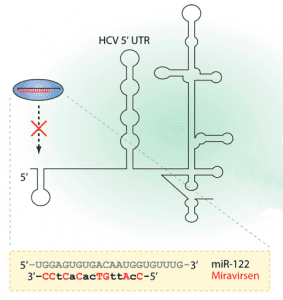

Are you surprised that the antiviral effect of Miravirsen is long lasting?
The Janssen study published in NEJM basically recapitulated what Lanford had observed in HCV-infected chimps treated with the compound, with a very slow onset of antiviral effect, and then a very slow rebound as well. This probably reflects the pharmacokinetics and very high stability of the locked nucleic acid compound, and the time required to sequester endogenous miR-122 €“ changes in serum cholesterol also move very slowly. I think this is why the antiviral effect (and cholesterol effect) are long-lasting.
Is it surprising that no resistance to Miravirsen was observed?
As for the lack of resistance, it doesn’t surprise me much. This was observed in the chimps as well. The virus is really dependent upon miR-122 for its replication, and can’t readily mutate around it – the requirement for miR-122 reflects more than just the stabilizing effect of miR-122 on the viral genome, as we showed in a recent PNAS paper (Li et al., Proc. Nat’l. Acad. Sci U.S.A., 110:1881-6, 2013) written in follow-up to our earlier demonstration of the stabilizing effect of the miRNA on the HCV genome (Shimakami et al., Proc. Nat’l. Acad. Sci U.S.A. 109: 941-6, 2012, that you reviewed in TWIV 180) – what we know and don’t know about the mechanism of action is summarized in an “opinion” piece now in press in RNA Biology.
Do you think this drug will ultimately get FDA approval?
Given issues of resistance, relapse, and poor pan-genotype coverage with direct-acting antivirals for HCV, all of this should bode well for Miravirsen. However, it has issues like almost all the new therapies under evaluation.
First, the spaghetti plots in the Janssen paper show large variation in the response of individual patients, with some having little effect when receiving Miravirsen. This is unlike studies with enzyme inhibitor antivirals, and I am not aware of any good reason for it other than potential variation in endogenous miR-122 abundance.
A second and greater issue is the cancer concern. Most hepatocellular carcinomas (except those associated with HCV, interestingly enough) demonstrate significant reductions in miR-122 abundance, and miR-122 can reverse some malignancy-associated features of transformed hepatocytes in vitro – thus, miR-122 seems to act much like a tumor suppressor in the liver. miR-122 knockout mice develop normally but have a high incidence of hepatocellular carcinoma. I think this poses real problems for the development of Miravirsen. While one could reasonably argue that short-term exposure to the antagomir is very different than gene knockout, the patients being treated are those at the highest risk for HCC – particularly if there is advanced fibrosis or cirrhosis, which characterizes those most in need of treatment. It is also clear that HCC can manifest itself in patients AFTER therapeutic elimination of the virus. The risk is most certainly greatly reduced, but it is not zero (HCC develops very slowly, and in a multi-centric fashion), and with the evidence that the drug has relatively long-lasting effects on cholesterol (as well as the virus), I think the developers of Miravirsen may find it difficult to defend against future claims that the drug contributed to the development of HCC in some cases. There isn’t a good way to de-risk this, to show that this theoretical concern is not real, and this must be worrying the regulatory authorities – especially since there are now many alternative therapies under evaluation that don’t carry this risk, some of which are looking very good in combination with each other (e.g., advanced NS3 inhibitors, NS5A inhibitors, and nucs).

Pingback: Treating hepatitis C by blocking a cellular microRNA | Viral Bioinformatics Resource Center
Pingback: TWiV 324: Viruses in the miR may appear more numerous